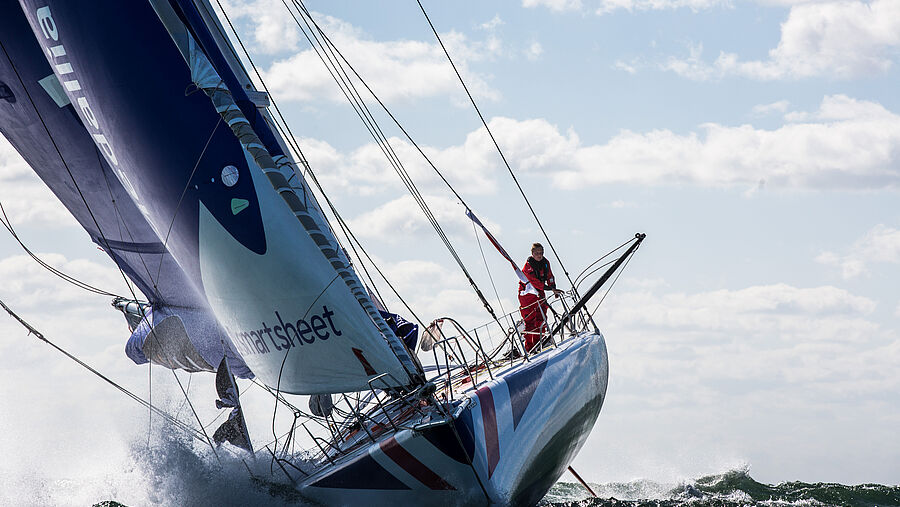
* Pantaenius UK Limited is authorised and regulated by the Financial Conduct Authority (Authorised No.308688)
Pantaenius recently chatted with John Parker from OneSails, delving into essential insights on maintaining and caring for sails.

1. What are the top tips for maintaining and caring for your sails, particularly during extended voyages?
2. What about during the winter, what’s the best practice when winterising your sails?
If you anticipate your boat won't be in use during the winter months, it's crucial to remove the sails to protect them from dampness, mildew, and potential damage from harsh weather conditions.
3. What are the most common areas of wear and tear or chafing to look out for on sails, and how can yacht owners prevent or address these issues?
High chafe areas are mostly found where the sails contact the spreaders, mast-mounted radars, stanchions, and guardrails. Well-placed spreader patches will help avoid chafe damage to the sails, “sail saver” coverings on the end of the spreaders will also help. If you have a mast mounted radar an anti-chafe patch on the jib leech is advisable. Split pins and obstructing metal should be covered with electrical tape as these are common culprits for causing sail damage. Topping lifts can also cause chafe when they rub against a mainsail so it is better to remove the topping lift from the aft end of the boom whilst on a long passage. Lazy jacks and runners are notorious “chafers” so be mindful to ease them to avoid chafing the leeward side of the sail.
4. What essential tools and materials should yacht owners carry onboard for basic sail repairs, especially on long passages where professional assistance may not be readily available?
Before the start of a season or setting off on a passage, visit your sailmaker and ask them to put together a modest sail repair kit based on the type of sails you have and the type of sailing you are doing. This ‘pack’ might include an assortment of needles, thread, and a sailmaker’s palm. Self-adhesive materials ranging from basic polyesters to aramids should be included as a handy addition. If you were stuck at sea without anything to hand most materials can be cut to make a patch and some form of adhesive (such as Sikaflex) would do the trick for a ‘temporary fix’ until you can see a sailmaker.
5. Can you share insights into the latest advancements in sail technology: particularly with OneSails' 4T FORTE™ continuous yarns composite design? How does this technology improve durability, performance, and overall sailing experience?
In sailmaking, the focus has shifted towards balancing performance and durability. OneSails leads this evolution with their 4T FORTE™ technology, featuring continuous yarns and a composite design that replaces traditional glues and mylar films. These sails are exceptionally durable, lighter by at least 25%, and offer carbon-like stretch properties. They enable sailors to complete demanding races like the Vendée Globe with one set of sails, showcasing their reliability in extreme conditions. This innovation not only extends the lifespan of sails but also reduces environmental impact, setting a new standard in sail making for both racing and cruising enthusiasts alike.
6. How does OneSails prioritise environmental sustainability in sail production? Can you explain the significance of the 4T FORTE™ sailing recycling process and the company's commitment to recycling and reusing materials?
Before founding OneSails International, CEO Dede De Luca was an America’s Cup sailor. After his last campaign, he was struck by the amount of sails destined for landfill and vowed to create a sustainable sailmaking network. Therefore, in 2015, OneSails introduced the 4T FORTE™ sail recycling process, achieving ISO 14040 Life Cycle Assessment Certification. It's the only fully recyclable sail membrane available today.
At our Suffolk loft, we've partnered with marine charity ReSail to recycle over 250 sails in the past year alone. This initiative has resonated widely, demonstrating sailors' commitment to reducing environmental impact. We now accept old sails and rope at our Suffolk and Hamble lofts. Inspired by the success, we've partnered with Suffolk At Play to repurpose materials into 'Scrapstore PlayPods', fostering creativity in schools and expanding our efforts to Bristol.
7. In what way does OneSails cater to individual yacht owners' needs with custom products and the development of vintage sails? How does this approach enhance the sailing experience?
Our business centres around custom work. Before making any sail, our first job is to engage with a customer to discuss how and where they intend to sail. Our team then designs the sails and chooses appropriate materials that best meet the customer’s requirements and budget. We have made sails for every shape, design, and size of boat from Optimists to superyachts.
8. With a global network of independent sail lofts, how does OneSails ensure consistent quality and service standards across different regions? What benefits does this network offer to yacht owners worldwide?
OneSails comprises 52 sail lofts owned by experienced sailmakers who are passionate sailors themselves. This ensures customers receive expert advice from knowledgeable sailors wherever they are in the world, whether cruising or racing.
Each loft meets rigorous standards to ensure quality, supported by a tailored code of best practice that considers regional conditions like weather and sea state. Collaboration within the group allows us to design sails that are precisely suited to each customer's unique needs and sailing environment, emphasising personalised solutions over one-size-fits-all approaches.
Therefore, with these useful insights from John Parker and ongoing guidance from Pantaenius on insurance, sailors can be fully empowered to safeguard their rigging, enhancing both safety at sea and their own peace of mind.